He claims to be haunted by an alter-ego.And he is probably right. Perhaps more than one. He is also becoming a celebrity; making noise in the world of pop art and serious art with haunting, surreal, and mysterious digital prints, all produced within several years after he decided to pursue art full time. His works combine varied aspects of his life experiences, including the sorrow and inspiration brought by deaths of loved ones, and his years spent viewing photos of and working with abused, neglected and deformed children in a hospital. There is something goth and whimsical about these children who resemble the human form yet radiate an enigmatic serenity that is other-worldly. But to label it as surreal would be unjustified. There is some notion of the riddle in Henri Rousseau, but something is lurking that is more profound: The mystery of Watteau- precision, control and goodness vs. chaos, abandon and violence- in the skin of a Fragonard or Francois Boucher.
Perfection is terrible, it cannot have children.
Cold as snow breath, it tamps the womb
Where the yew trees blow like hydras,
The tree of life and the tree of life
Unloosing their moons, month after month, to no purpose.
The blood flood is the flood of love,
The absolute sacrifice.
It means: no more idols but me,
Me and you.
So, in their sulfur loveliness, in their smiles
These mannequins lean tonight
In Munich, morgue between Paris and Rome,
Naked and bald in their furs,
Orange lollies on silver sticks,
Intolerable, without mind.
The snow drops its pieces of darkness,…. ( Sylvia Plath , Munich Mannequins)
In a sense it is surreal work. It is perfect, yet it is haunted by a certain terror.The motion is enhanced by the three-d imaging which projects the idea that we are entering a game; the “gaze” again into an odd social drama. The pop-art label is just to hang the narrative . Its not so much surreal as a hyper realism; objective realism crashing into a dreamworld. The digitally created dream scapes, also convey an alienation and isolation that is not dissimilar to Edward Hopper. There is no pinning this work down. The works are often set in elaborately furnished Rococo-style interiors,which connotes another influence: Italian Mannerism. The haunting doll-like female figures with porcelain features and complexions are composite characters that are part-child-part-woman.For all the suggestions of fetish in these figures there is an enigmatic counter impulse of mortality that could be connected to a Henry Fuseli. Caesar’s art is simultaneously visually beautiful and frightening. These digital portraits are about perfection,and the forging of the self, in all its distorted anguish toward this impossible ideal. “Perfection i
rrible,” wrote Sylvia Plath, who understood, of course. “It cannot have children.”By this, the poet means that perfection is not real, and to pursue it, as in the magnificent blueprint for The Black Swan, The Red Shoes (which I believe is a veiled recasting of the anguished relationship between dancer Vaslav Nijinsky and Ballet Russe founder Sergei Diaghilev), is to pursue one’s own – flawless, static – death.
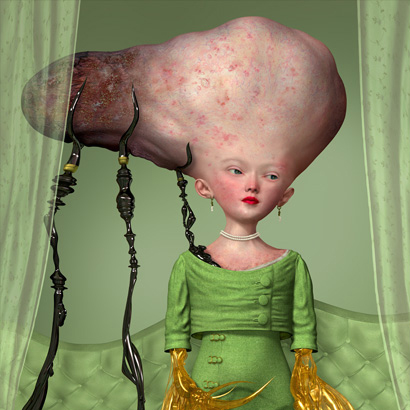
"Ray Caesar’s works are done completely in the computer, painted with ones and zeros, and I love every pixel of them. Personally, I’m still very attached to the physical object that is a traditional painting and would have a hard time having my work exist only in the digital realm, but Caesar makes a great case for the medium. " read more: http://www.paintblog.ca/2008/02/27/ray-caesar/ image: http://retort.brentley.com/retortpress/2010/02/10/art-by-ray-caesar/
RAY: Well! I started out going to school and working as a architect then somehow got into medical graphics and later in life worked for several years in animation and special effects. In between all that I have done questionable things like the time I sold pantyhose as a sideline business and a serious attempt at becoming a MUFON investigator (Mutual UFO Network). I spent 17 years working in a Children’s hospital and I suppose that’s why I am making these images today. I saw so much in that place that I can hardly talk or think about it without becoming emotional….
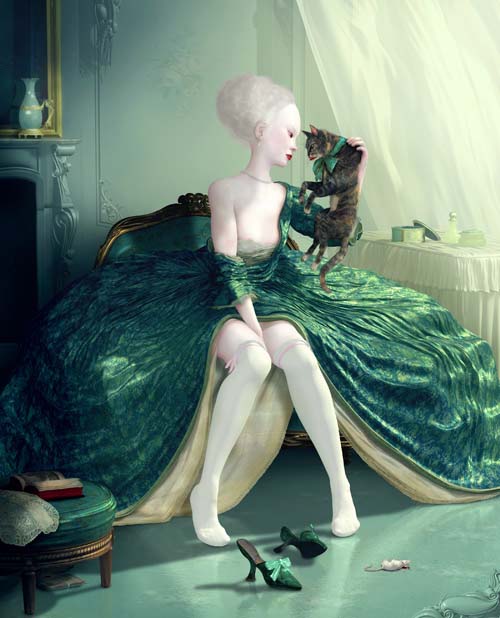
"It is obvious that in your works there is a lot of loneliness of suffering; will this ever end? I don't see it that way ......... there is certainly the visual cues to loneliness and suffering but I am much too much of an optimist to let that be all there is. I see my figures as calm ... I see them without fear, with a secret knowing and even humor. I think they are happy and they are challenging us to see them as they are! without flinching... to see them without our own fear. Where some see loneliness I see calm serenity........ where some see suffering or pain I see unique knowledge tried by fire and the call to all to overcome and share that suffering. The ability to embrace difference and not be afraid of it. like a small heaven of my own making for some wizened spirit residing in the hidden rooms of my memory......... perhaps in this heaven its not what we see ... but how we choose to see it. read more: http://art.webesteem.pl/13/caesar_en.php
I hated making art for so many years, It never occurred to me to show it in a gallery and I didn’t even want to put it up on my own wall. The act of making it was not pleasant but for some reason it was an obsession. Read More: http://www.pixelsurgeon.com/interviews/interview.php?id=144
Caesar also struggles with dissociative identity disorder: more commonly known as multiple personality disorder.Essentially, the self appears to dissociate, or divide into seperate and distinct personalities in an effort to repress the pain and terror of some tramatic event. The trauma in many cases is often sexual in nature. There is one prevalent theory that implies that the blocked pain, terror, and awareness create compartments in the mind, which hold the unprocessed feelings. When these compartments ” leak” or are triggered according to the theory, the person has flashbacks, panic attacks, and nightmares. Individuals stricken with DID may experience the onslaught of the disturbance suddenly or gradually, and the symptoms may become worse over a long period of time. Recent studies indicate that the age of onset is nearly always childhood, and that it is much more common among women then men; as much as three to nine times more:
“The whole phenomenon is like watching a movie, relating to the character of the movie and going through all the situations that he goes through but at no point of time do we forget our own identity but then there are some people who fail to do that. They assume the identity of the other character and thus release their suppressed feelings and emotions in this kind of a mitigated way.
One personality is absolutely oblivious of the other one’s presence but both the personalities take control of the individual at regular intervals but then there is no shared memory. The most interesting characteristic of this disorder is that the alternate personality is an individual in it and has its own history and array of experiences. Gender and voice also changes, at times the alternate personality shows features like weak eyesight. Isn’t it surprising that two personalities exist in the same body and manipulate the body as per their requirements and all this is facilitated by the power of human brain? read more: http://www.buzzle.com/articles/dissociative-identity-disorder.html
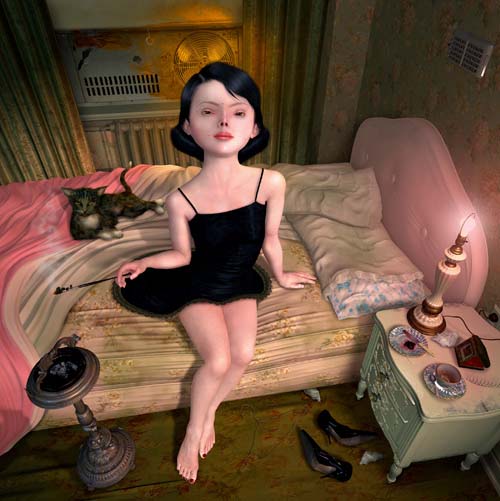
"Viewers take in a seemingly innocent setting of nimble Victorian dolls, only to be confronted by a darker reality once they delve further into Ray’s images where things are not always as they seem. The surrealist art has been labelled as representative of loneliness, sadness and tragedy, but Ray views his images in a different manner. “For me, my work is very personal and I see a lot of hope and calm. My figures are not afraid of the dark as that is a place they call home,” he explains. “They are aspects of my subconscious and it’s our subconscious that is the dark side of our personality. We can be afraid of the dark or we can go into a dark room and feel around with our hands and see the room in a different way than what we see with the lights on. ..." Read More: http://www.ionmagazine.ca/2010/05/ray-caesar/
ADDENDUM:
Read More: http://art.webesteem.pl/13/caesar_en.php
http://www.onnovdhart.nl/articles/Moleman_Hart94.pdf
http://www.ionmagazine.ca/2010/05/ray-caesar/
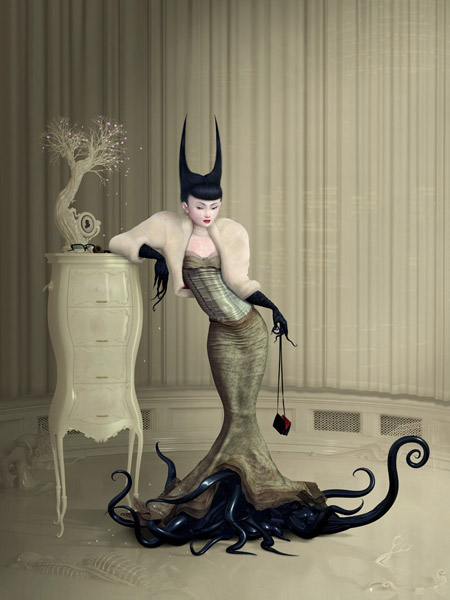
"Do you remember your last dream? I always remember my dreams..... every single detail. last night I was in an amazing chamber or building with large open windows to an ancient city at night... it was in Biblical times ... possibly Egypt or Jerusalem ... I was a priest in some kind of robe and remember walking through the dark halls of this magnificent building .... I came to a room and I was examining an amulet of twisted heart flesh shaped like a Ankh that was tied with string ... it was sitting in a stone bowl in a shallow puddle of blood..... something told me I had made this amulet...." read more: http://art.webesteem.pl/13/caesar_en.php image: http://www.hautstyle.co.uk/tag/ray-caesar/
I have read that many of your works are a combination of multiple ideas or environments. How do you start a new piece? Does it begin with a series of sketches? Do you have a final picture and work towards it?
Ray Caesar: I just begin and that beginning will have very little relationship with the final piece as I work intuitively with no such thing as a plan. I just start playing and when I begin I might end up with several different pieces which all go in a variety of direction. I draw and make studies both traditional and digital and mix the two. I often make a montage of unusual found images and may print those out as large sheets and bind them in a small book … might put that with sketches and studies and then put the whole thing away for months or even years. Eventually I start to model and just have fun without a care in the world. Just like a kid playing alone in their room … I just let my imagination take me where it wants to go. Often I feel something else starts to take control and whatever I had planned is secondary to what that piece wants to become. Read More: http://www.theworldsbestever.com/2008/11/12/10-questions-with-ray-caesar/
.The process, in my experience of making art, is that occasionally the art guides you. I believe it was Michelangelo, who said something to the effect that “The sculpture is within the stone and I am releasing it”(yes, a massive paraphrase). Do you feel the worlds you have created now have a life of their own?
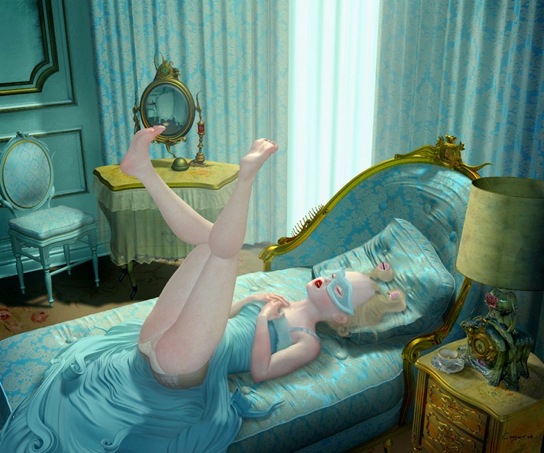
"I love every form of image making I can think of ..old paintings, fashion photography from the fifties and comic books from the sixties and “I Love Lucy Shows” and Knitting pattern books my Mom used to have…sifting through antiques and old Victorian underwear and the regency period of Jane Austen, old Japanese movies of the 1940s and 50s…the past and the future we thought we would have is a vast cornucopia of amazement to me…I love it all…I just haven’t got to it all yet and I have put in a requisition for several more lifetimes so I can do it all. I haven’t heard back from the head office but if I don’t get those lifetimes I am going to steal them…either that or Iam never going to die…one or the other." read more:http://www.theworldsbestever.com/2008/11/12/10-questions-with-ray-caesar/ image: http://www.mymodernmet.com/profiles/blogs/digital-art-masterpieces-ray
I have a notion that when I wrap skin around a model and start to give it a breath of life it takes over …something begins to inhabit that skin again like a long lost soul. All my efforts are put into making a little heaven for that lost spirit as I make a place it can call its own and a place it can spend eternity. This is just my personal mythology that I choose to believe. I see each of my completed pieces as a kind of shrine to set of emotions and feelings that come thru me as I create and I am not sure if those emotions are mine or belong to something else. I often find this process disturbing but also necessary as its been what my entire life has been about so I have learned the hard way not to ignore such things. … Read More: http://www.theworldsbestever.com/2008/11/12/10-questions-with-ray-caesar/
——————————————————————————————————————
Dissociative Identity Disorder is not a very common and attainable way of coping with severe trauma. Not everyone can live a different life and cope with their trauma and overpowering stress. This kind of a psychological disorder is common to people who experience acute physical, mental, sexual and emotional abuse at home or outside. To bear mental pressure of great magnitude and channelise the resultant feeling in a tolerable fashion it becomes necessary for the mind to create another personality who would be in someway resistant to the pains. Individuals who have the same kind of childhood yet they live a healthy psychological life do have one or the other kind like lack of confidence or severe temper tantrums. It can be said that it is the defense mechanism of the mind that creates this different personality. Dissociative Identity disorder happens at childhood and very rarely at a matured age because adults know of other ways to vent their pent up feelings. Read More: http://www.buzzle.com/articles/dissociative-identity-disorder.html
———————————————————————————————–
Karen E. Hart: Creative Art Therapy has also been touted as having tremendous worth in the treatment of MPD/DID as it readily converts the paradoxes, cognitive errors and other inconsistencies of this disorder into tangible form. According to Cox and Cohen (2005), clients with MPD/DID paradoxically overcome their stymied verbal abilities and express what was repressed for years by graphically layering symbolic meanings while still being in control of the rate of disclosure. Often the artwork work depicts the client’s internal political system, abreactions, chaos, fragmentation, barriers, threats, induction, trance, switching and alert states.






 COMMENTS
COMMENTS